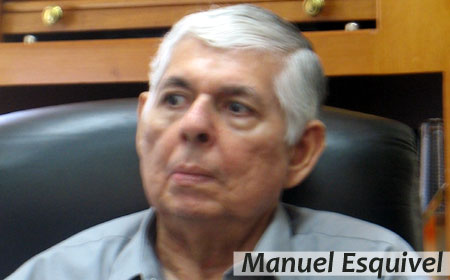BELIZE CITY, Wed. June 3, 2015–Former Prime Minister Sir Manuel Esquivel told Amandala today that there is the need for the Belize flag to be standardized, with formal specifications documented for the colors of the flag, as well as the intricate design details which define it. At the time of Independence, he said, the flags were sewn and hand-painted in Belize.
However, he told us that beyond talking about the specs of the Belize flag – which exists in an endless variation due to mass production by various establishments, perhaps beginning in the 1990s – the wise course of action would be to remove the men from the flag altogether. Although he agrees that such a move would be controversial, he said that to only portray a black and a brown man on the flag is hardly representative of the ethnically diverse people of Belize.
Esquivel pointed to the fact that the Belize flag is the only flag with people on it – which, he told us, was “a bad idea.”
When the national flag was being designed, he was one of the persons who sat on a committee comprised of persons from the People’s United Party and the United Democratic Party, tasked with coming up with a national flag.
According to Esquivel, the forerunner to the flag was sky blue and it did not have any red on it. The thought was that it would be impossible to get Belizeans to rally together under a flag which clearly represented the ruling party at the time. So the solution was introducing some red – the color of the United Democratic Party.
Esquivel recalls that the late Everald Waight (one of the persons who had reportedly won a competition to help design the flag) had suggested a full red border, but Esquivel suggested that the flag would then look like a tablecloth, so Esquivel proposed that the red band should be limited to the top and the bottom of the flag, the way it appears today. The design calls for each red band to span a tenth of the width of the flag.
It had already been settled that the Coat of Arms, inherited as a symbol from the British, should lie at the center, and at the time, one of the two men on the coat of arms, which the British originally designed as two African woodcutters, would be changed to a person of lighter skin tone. This is the version of the flag which is now the official flag of Belize.
Last week, when some Belizeans expressed their dismay over the version of the Belize flag that was used by the Guatemalans at the signing of the amendment to the agreement for the International Court of Justice, we were advised that there is nothing officially documenting and comprehensively defining the Belizean flag, and we were told that this “leaves room for people to maneuver…”
We understand that some years ago, a team of Government reps had been assigned to research and document information on the Belize flag; and apart from gathering historical information, the group also looked at the specific colors that are to be used for the national flag, such as the exact shade of blue and red.
While the official standard for the Belize flag has remained virtually unchanged over the years, there have been notable variances in the design of the Coat of Arms, the main one being changes in the color of the persons on the flag.
Esquivel said the change from two dark men to a light brown and dark man happened perhaps during the period of self-government. Another source told us that the directive to the Belize printers to lighten one of the men came down from the Government after Independence. However, the version of the flag housed at the George Price Center (the flag flown in Belize at Independence) also depicts the lighter-skinned man with brown hair, while the other man has black hair.
Esquivel believes that the flag should not just depict two races: which are now deemed to be those of African ancestry and the Mestizos and not two African woodcutters, as originally specified by the British for the Coat of Arms.
He also believes that the description of the official Belize flag should be enshrined in legislation, but in order to remove political bias from the process, a foreign expert should be engaged for this.
We understand that there has been no action on the documentation prepared by the group of Government reps who were tasked to document the features of the Belize flag, but the hope is that the document could feed into a larger document with all the national symbols, which would then be forwarded to Cabinet to initiate the formalization of how the flag and the national symbols of Belize should be represented.
(Note: Mr. Esquivel served as Belize’s Prime Minister, under the banner of the UDP, from 1984-1989 and from 1993-1998.)

